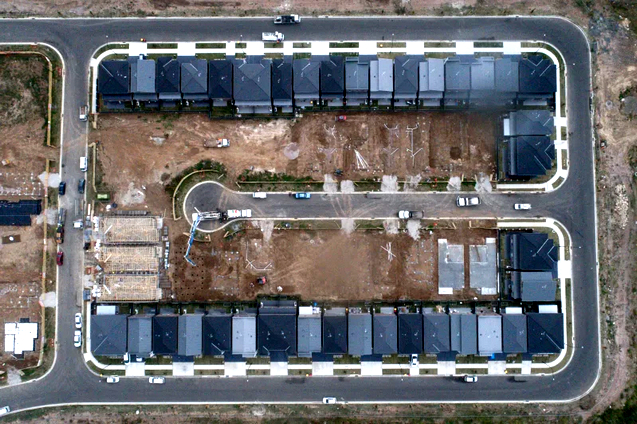Dark roofing will be banned in Sydney’s south-west growth area in an attempt by the NSW government to dial back the heat island effect while providing sorely needed new homes.
Lighter coloured roofs will be a mandatory part of the planning controls for the Wilton area, busting the march of Colorbond Ironstone that has long been synonymous with Australian urban sprawl.

|
|
The dark rooftops of Sydney’s urban sprawl will come to a halt
under new government regulations. Credit: Nick Moir
|
NSW Planning and Public Spaces Minister Rob Stokes said the report showed if the planning system didn’t take the construction of buildings and infrastructure more seriously, there could be catastrophic impacts on health, the economy and environment.
He said Wilton demonstrated how the issue could be confronted.
“Western Sydney already experiences blistering temperatures of over 50 degrees in summer. The need to adapt and mitigate urban heat isn’t a future challenge – it’s already with us,” Mr Stokes said, adding that the report would also be used to influence the government’s major city-planning draft policy, Design and Place.
“When designing lots for detached housing, we need backyards which are big enough to plant a tree or have a garden.
"We need to say goodbye to the trend of having dark roofs that not only attract and retain heat and raise ambient street temperatures, but lead to astronomical electricity bills because of the need to cool homes.”

|
|
Darker roofs contribute to western Sydney’s heat island effect by
creating more radiant heat and higher energy consumption. Credit: Wolter Peeters
|
Western Sydney University urban heat expert Sebastian Pfautsch has gauged the canopy cover of various suburbs and found a section of Marsden Park, in the north-west, has 1 per cent, while parts of Wahroonga, on the upper north shore have more than 60 per cent.

|
|
An artist’s concept of the new Wilton neighbourhood in Sydney’s
south-west growth area. Credit: NSW Government
|
Extreme weather
|
|
|
He said if the planning system persisted with freestanding homes, they needed to be more vertical, with lower floor space, allowing for greater ventilation, evaporative cooling and passive circulation, adding, “We need to move away from flat and wide.”
University of NSW Professor Mattheos Santamouris, who has had an extensive career researching urban heat, said so-called “cool roofs” could decrease the energy consumption of uninsulated buildings in western Sydney by up to 50 per cent, and several countries already regulated this.
He said western Sydney, where summer extremes were consistently far hotter than the east, was affected by desert winds, and radiant temperatures from dark roofing exacerbated the synoptic effects of this.
Global warming 
|
|
|
“It will result in bureaucratically imposed blandness for new communities and will bring negligible improvement in thermal performance that could be achieved through new technologies in insulation, approaches to building design and shading, and other measures,” he said.
“We also object to the control that requires bigger backyards for the planting of trees ... How will government police compliance with this? Will swimming pools and garden sheds be prohibited?”
Links
- (AU ABC) Study Finds Green Roofs Make Solar Panels More Efficient
- (AU) The City Of Sydney Is Opening A Massive Tech Innovation Hub In Salesforce Tower To Help Tackle Climate Change
- Climate Change Projects Headline Innovation And Science Australia's 2030 Plan
- Transforming Waste Into Fuel With Australian Innovations, From Tyres To Sugar Cane And Agave
- Solar Technology: The Us And China Look To Australian Innovators For Solutions

No comments:
Post a Comment